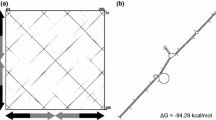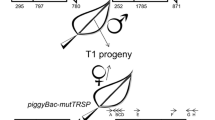Abstract
Doppia (Dop) transposable elements were first identified from element termini found in the upstream portions of certain alleles of the pl1 and r1 loci of maize. At the r1 locus, these Dop end sequences are present in a region called σ, which functions as the promoter for the S genes of the R-r haplotype, and which is required for efficient epigenetic modification of the S genes during paramutation. In order to better understand the significance of the Dop element sequences at R-r, and to investigate the Dop-encoded products that might regulate r1 genes in this haplotype, we have cloned a more complete Dop element, Dop4. The Dop4 element can encode two proteins that have strong sequence similarity to the TnpA and TnpD proteins of the well characterized maize transposable element En/Spm. The DOPA protein, which is similar to TnpA of En/Spm, is shown to bind to short, subterminal repeat motifs located in the Dop element ends. Like TnpA, DOPA promotes intermolecular associations between DNA molecules. In contrast to the activity of TnpA, which is a transcriptional repressor of En/Spm, DOPA activates expression of reporter genes driven by either the Dop promoter or σ in transient expression assays.
Similar content being viewed by others
References
Altschul, S.F., Madden, T.L., Schäffer, A.A., Zhang, J., Zhang, Z., Miller, W. and Lipman, D.J. 1997. Gapped BLAST and PSI–BLAST: a new generation of protein database search programs. Nucl. Acids Res. 25: 3389–3402.
Banks, J., Masson, P. and Federoff, N. 1988. Molecular mechanisms in the developmental regulation of the maize Suppressor–mutator tansposable elements. Genes Dev. 2: 1364–1380.
Barkan, A. and Martienssen, R.A. 1991. Inactivation of maize transposon Mu suppresses a mutant phenotype by activating an outward–reading promoter near the end of Mu1. Proc. Natl. Acad. Sci. USA 88: 3502–3506.
Chopra, S., Brendel, V., Zhang, J., Axtell, J.D. and Peterson, T. 1999. Molecular characterization of a mutable pigmentation phe–notype and isolation of the first active transposable element from Sorghum bicolorr. Proc. Natl. Acad. Sci. USA 96: 15330–15335.
Cone, K.C., Cocciolone, S.M., Moehlenkamp, C.A., Weber, T., Drummond, B.J., Tagliani, L.A., Bowen, B.A. and Perrot, G.H. 1993. Role of the regulatory gene pl in the photocontrol of maize anthocyanin pigmentation. Plant Cell 5: 1807–1816.
Fedoroff, N. 1996. Epigenetic regulation of the maize Spm trans–posable element. In: V.E.A. Russo, R.A. Martienssen and A.D. Riggs (Eds.) Epigenetic Mechanisms of Gene Regulation, Cold Spring Harbor Laboratory Press, Plainview, NY, pp. 575–592.
Frey, M., Reinecke, J., Grant, S., Saedler, H. and Gierl, A. 1990. Ex–cision of the En/Spm transposable element of Zea mays requires two element–encoded proteins. Journal??? 9: 4037–4044.
Gierl, A., Lutticke, S. and Saedler, H. 1988. TnpA product encoded by the transposable element En–1 of Zea mays is a DNA binding protein. EMBO J. 7: 4045–4053.
Grant, S.R., Gierl, A. and Saedler, H. 1990. En/Spm encoded tnpA protein requires a specific target sequence for suppression. EMBO. J. 9: 2029–2035.
Grant, S.R., Hardenack, S., Trentmann, S. and Saedler, H. 1993. Functional cis–element sequence requirements for suppression of gene expression by the TNPA protein of the Zea mays transposon En/Spm. Mol. Gen. Genet. 241: 153–160.
Hebsgaard, S.M., Korning, P.G., Tolstrup, N., Engelbrecht, J., Rouze, P. and Brunak, S. 1996. Splice site prediction in Ara–bidopsis thaliana DNA by combining local and global sequence information. Nucl. Acids Res. 24: 3439–3452.
Kermicle, J. 1996. Epigenetic silencing and activation of a maize r gene. In: V.E.A. Russo, R.A. Martienssen and A.D. Riggs (Eds.) Epigenetic Mechanisms of Gene Regulation, Cold Spring Harbor Laboratory Press, Plainview,NY, pp. 267—287.
Martienssen, R. and Baron, A. 1994. Coordinate suppression of mutations caused by Robertson's Mutator transposons in maize. Genetics 136: 1157–1170.
Masson, P., Surosky, R., Kingsbury, J.A. and Federoff, N. 1987. Ge–netic and molecular analysis of the Spm–dependent a–m2 alleles of the maize a locus. Genetics 177: 117–137.
Masson, P., Rutherford, G., Banks, J.A. and Fedoroff, N.V. 1989. Essential large transcripts of the maize Spm transposable element are generated by alternative splicing. Cell 58: 755–765.
Masson, P., Banks, J.A. and Fedoroff, N. 1991. Structure and function of the maize Spm transposable element. Biochimie 73: 5–8.
Masson, P., Strem, M. and Fedoroff, N. 1991. The tnpA and tnpD gene products of the Spm element are required for transposition in tobacco. Plant Cell 3: 73–85.
May, B.P. and Dellaporta, S.L. 1998. Transposon sequences drive tissue–specific expression of the maize regulatory gene R–s.Plant J. 13: 241–247.
McClintock, B. 1958.The Suppressor–mutator system of control of gene action in maize. Carnegie Inst. Wash. Year Book 57: 415–429.
McClintock, B. 1962. Topographical relations between elements of control systems in maize. Carnegie Inst. Wash. Year Book 61: 448–461.
Mukhopadhyay, G., Sozhamannan, S. and Chattoraj, D.K. 1994 Re–laxation of replication control in chaperone–independent initiator mutants of plasmid P1. EMBO J. 13: 2089–2096.
Nacken, W.K.F., Piotrawiak, R., Saedler, H. and Sommer, H. 1991. The transposable element Tam1 from Antirrhinum majus shows structural homology to the maize transposon En/Spm and has no sequence specificity of insertion. Mol. Gen. Genet. 228: 201–208.
Nelson, O.E. and Klein, A.S. 1984. Characterization of an Spm–controlled bronze–mutable allele in maize. Genetics 106: 769–779.
Ozeki, Y., Davies, E. and Takeda, J. 1997. Somatic variation during long term subculturing of plant cells caused by insertion of a transposable element in a phenylalanine ammonia–lyase (PAL) gene. Mol. Gen. Genet. 254: 407–416.
Panavas, T., Weir, J. and Walker, E. 1999. The structure and para–mutagenicity of the R–marbled haplotype of Zea mays. Genetics 153: 979–991.
Pereira, A., Cuypers, H., Gierl, A., Schwartz–Sommer, Z. and Saedler, H. 1986. Molecular analysis of the En/Spm transposable element system of Zea mays. EMBO J. 5: 835–841.
Raina, R., Cook, D. and Fedoroff, N. 1993. Maize Spm transposable element has an enhancer–insensitive promoter. Proc. Natl. Acad. Sci. USA 90: 6355–6359.
Raina, R., Schlappi, M., Karunanandaa, B., Elhofy, A. and Fedoroff, N. 1998. Concerted formation of macromolecular Suppressor–mutator transposition complexes. Proc. Natl. Acad. Sci. USA 95: 8526–8531.
Rhodes, P.R. and Vodkin, L.O. 1988. Organization of the Tgm family of transposable elements in soybean. Genetics 120: 597–604.
Sambrook, J., Fritsch, E.F. and Maniatis, T. 1989. Molecular Cloning: A Laboratory Manual, 2nd ed. Cold Spring Harbor Laboratory Press, Plainview,NY.
Schiefelbein, J.W., Raboy, V., Kim, H.–Y. and Nelson, O.E. 1988. Molecular charcaterization of Suppressor–mutator (Spm)–induced mutatins at the bronze–1 locus in maize: the bz–m13 alleles. In: E.E. Nelson (Ed.) Plant Transposable Elements, Plenum, New York, pp. 261–278.
Schlappi, M., Raina, R. and Fedoroff, N. 1994. Epigenetic regula–tion of the maize Spm transposable element: novel activation of a methylated promoter by TnpA. Cell 77: 427–437.
Schneider, M., Ow, D.W. and Howell, S.H. 1990. The in vivo pattern of firefly luciferase expression in transgenic plants. Plant Mol. Biol. 14: 935–947.
Schwarz–Sommer, Z., Gierl, A., Cuypers, H., Peterson, P.A. and Saedler, H. 1985. Plant transposable elements generate the sequence diversity needed in evolution. EMBO J. 4: 591–597.
Snowden, K.C. and Napoli, C.A. 1998. Ps1: a novel Spm–like transposable element from Petunia hybrida. Plant J. 14: 43–54.
Trentmann, S.M., Saedler, H. and Gierl, A. 1993. The transposable element En/Spm–encoded TNPA protein contains a DNA binding and a dimerization domain. Mol. Gen. Genet. 238: 201–208.
Walker, E.L. 1998. Paramutation of the r1 locus of maize is as–sociated with increased cytosine methylation. Genetics 148: 1973–1981.
Walker, E.L., Robbins, T.P., Bureau, T.E., Kermicle, J. and Della–porta, S.L. 1995. Transposon mediated chromosomal rearrange–ments and gene duplications in the formation of the maize R–r complex. EMBO J. 14: 2350–2363.
Walker, E.L., Eggleston, W.B., Demopoulos, D., Kermicle, J.L. and Dellaporta, S.L. 1997. Insertions of a novel class of transposable elements with a strong target site preference at the R complex of maize. Genetics 146: 681–693.
Author information
Authors and Affiliations
Rights and permissions
About this article
Cite this article
Bercury, S.D., Panavas, T., Irenze, K. et al. Molecular analysis of the Doppia transposable element of maize. Plant Mol Biol 47, 341–351 (2001). https://doi.org/10.1023/A:1011606529513
Issue Date:
DOI: https://doi.org/10.1023/A:1011606529513




